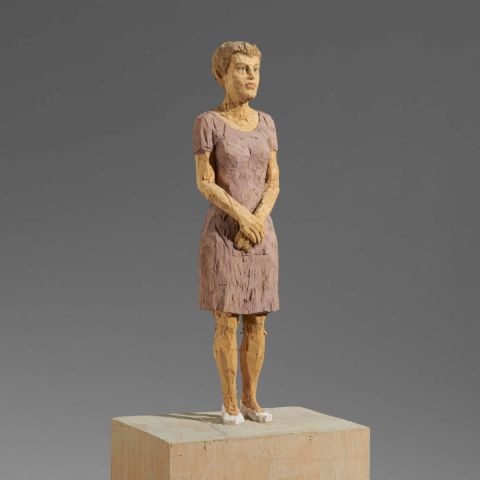
Lot 9 | Käthe Kollwitz | Drei Studien einer Arbeiterfrau
1867 Königsberg - 1945 Moritzburg
Title: Drei Studien einer Arbeiterfrau.
Date: Ca. 1905.
Technique: Charcoal on laid paper.
Measurement: 51 x 71cm.
Notation: Signed lower right: Käthe Kollwitz.
Frame/Pedestal: Craftman's frame.
Provenance:
- Teresa Marquez Collection, New York
- Sindin Galleries, New York
- Galerie Utermann, Dortmund (1989)
- Private collection, South America/Germany
Exhibitions:
- Galerie Ernst Arnold, Dresden, 1919
Literature:
- Nagel, Otto (ed.): Käthe Kollwitz - Die Handzeichnungen, Berlin 1972, cat. rais. no. 362, ill.
- Exhibition catalogue Handzeichnungen deutscher Meister, Galerie Ernst Arnold, Dresden 1919, cat. no. 141, ill. p. 51
- Early charcoal study of touching power and exceptional draughtsmanship
- A characteristic sheet from the theme of working-class life
- With sensitive precision, the artist lends her powerful portraits of women a dignity that was previously unknown in art
"I found the porters of Königsberg beautiful, the Polish Jimkies on their Witinnen beautiful, the generosity of the people's movements beautiful. People from bourgeois life held no appeal for me. The whole of bourgeois life seemed pedantic to me. In contrast, the proletariat was a great success." (Käthe Kollwitz in: Rückblick auf frühere Zeit (1941), quoted from Bohnke-Kollwitz, Jutta: Käthe Kollwitz. Die Tagebücher 1908-1943, Munich, 2nd edition, 2018, pp. 736-744, p. 741)
The world of workers
Käthe Kollwitz was the best-known and most successful artist in Germany during her lifetime. Even then, she enjoyed worldwide renown, and her significance continues unabated to this day. The artist's distinctive drawings, prints and sculptures have become indelibly etched in our cultural memory. In her socially engaged work, she devoted herself like few others to the great themes of humanity: the lives and sufferings of ordinary people, poverty and social injustice, motherhood and loss, the horrors of war and death. Empathy and compassion characterise her entire oeuvre. She often gives a voice to the socially marginalised and disadvantaged, lending impressive visibility to their struggle for a dignified existence.
In her early drawings and prints, Kollwitz focuses her attention on the proletariat with great artistic interest and a keen sense of social reality and human destiny. She felt connected to the world of the "common people" from her youth, when she and her sister Lise would roam the harbour district of their hometown Königsberg. The depictions of working-class life gave her "simply and unconditionally" what she "found beautiful" (quoted from ibid.).
Later, in the Berlin medical practice of her husband, Dr. Karl Kollwitz, she experienced first-hand the harsh and deprived reality of life for the urban proletariat and recognised the full extent, severity and existential hardship of working-class life. She often portrayed working-class women, whose faces bore the deep traces of a worrisome everyday life overshadowed by poverty.
"Drei Studien einer Arbeiterfrau" (Three studies of a working-class woman)
This charcoal drawing from around 1905 is a sensitive study of three female figures in different perspectives and body language. With a slightly stooped posture, downcast eyes, one hand on their chin or both hands brought together close to their bodies in a reserved gesture, the women appear thoughtful and introverted. With a few concise strokes and dense black hatching, the artist captures the expression and emotional mood of her models. The burden of existence weighs heavily on their shoulders. The study – which finds its way into the artist's graphic and drawing work in several expressive motifs – reveals not only Kollwitz's masterful powers of observation and confident drawing skills, but also her deep sympathy for human fate and a sensitive awareness of the quiet melancholy of existence.
Doris Hansmann
+49 221 92 58 62 304
Print this lot | Recommend lot |
Conditions of this Lot
32% buyer’s premium on the hammer price
Estimated shipping costs for this lot:
Arrangement after the auction.
Käthe Kollwitz Germany Berlin Secession Modern Art 1900s Craftman's frame Woman Works on paper Charcoal
More lots which could be of your interest
- Estimate: 50.000 - 70.000 €
03.12.2025 - ca.18:06Modern | Post War | Contemporary | Galerie Thomas | The Jagdfeld Collection | Auction 03.12.2025






